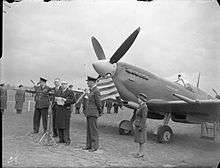Uruguay during World War II


Uruguay stayed neutral during most of World War II, despite internal disputes and pressure to join the Allies. Great Britain remained an influential power during all of the conflict, with the notable activity of Sir Eugen Millington-Drake, British Minister in Montevideo.[1]
Graf Spee
On December 13, 1939 the Battle of the River Plate took place off the coast of Uruguay between British forces and the German "pocket battleship" Admiral Graf Spee. After a 72-hour layover in port of Montevideo the captain of the Graf Spee, believing he was hopelessly outnumbered by the British, ordered the ship to be scuttled. Most of the surviving crew of 1,150 were interned in Uruguay and Argentina and many remained after the war. A German Embassy official in Uruguay said his government has sent an official letter stating its position as to whether Germany claims ownership of the vessel. The German claim would be invalid because early in 1940 the Nazi government sold salvaging rights to the vessel to a Uruguayan businessman who was acting on behalf of the British government. However, any salvaging rights would have expired under Uruguayan law.[2] By 1940 Germany had threatened to break off diplomatic relations with Uruguay.[3] Germany protested that Uruguay gave safe harbor to the HMS Carnarvon Castle after it was attacked by a Nazi raider.[4] The ship was repaired with steel plate reportedly salvaged from the Graf Spee.[5]
Declaration of war
On January 25, 1942 Uruguay broke diplomatic relations with Nazi Germany, as 21 American nations did the same (except for Argentina).[6] In 1945, it formally joined the Declaration by United Nations; Uruguay declared war on Germany and Japan on 15 February.
See also
References
- ↑ "Sir Eugen Millington-Drake in Uruguay". Janus. Retrieved 6 October 2014.
- ↑ Rohter, Larry (2006-08-25). "A Swastika, 60 Years Submerged, Still Inflames Debate". New York Times. Retrieved 2008-05-19.
For more than 60 years, the scuttled wreck of the Graf Spee rested undisturbed in 65 feet of murky water just outside the harbor here. But now that fragments of the vessel, once the pride of the Nazi fleet, are being recovered, a new battle has broken out over who owns those spoils and what should be done with them.
- ↑ White, John W. (June 20, 1940). "Minister Ready to Ask for His Passports if Any Local Nazi Leaders Are Deported". New York Times. Retrieved 2009-05-22.
Germany has now begun to exert tremendous political and economic pressure on the Uruguayan Government to halt what Berlin calls an unfriendly anti-German campaign here. The Reich has threatened to break off diplomatic relations if any Nazi leaders are deported.
- ↑ White, John W. (December 10, 1940). "Nazis Protest Aid to Raider's Victim. Object in Uruguay to Giving Carnarvon Castle 72 Hours to Mend Battle Scars". New York Times. Retrieved 2009-05-22.
The German Government, through its Minister in Montevideo, Otto Langmann, made a formal diplomatic protest this afternoon against...
- ↑ "Search For Raider". New York Times. December 9, 1940. Retrieved 2009-05-22.
The British auxiliary cruiser Carnarvon Castle, hit twenty-two times in a battle with a German sea raider, was being repaired tonight with steel plates reportedly taken from the scuttled German pocket battleship Admiral Graf Spee.
- ↑ Hulen, Bertram D. (January 22, 1942). "Actual Rupture Is Left to Congress of Each Signatory". New York Times. Retrieved 2009-05-22.
Unanimous agreement by the twenty-one American republics on a resolution for severance of relations with the Axis powers was reached late today at a three-hour consultation in the office of Foreign Minister Oswaldo Aranha of Brazil, who is chairman of the Inter-American Conference.
| Wikimedia Commons has media related to Uruguay during World War II. |